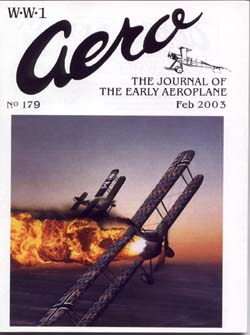 WW1 Aero WW1 Aero
The Journal Of The Early Aeroplane
No. 179, February 2003
The editor's comments indicate that he quite likes this issue's cover graphic by UK artist T. L. Wakefield. Personally I find it a bit lurid and hard to ACCEPT. I believe Mr. Wakefield has been over influenced by the current TV and movie vogue for great balls of orange fire; he has gotten the flames out of all proportion to the object being consumed. Could an LVG have enough fuel aboard to produce such a large and enduring conflagration? That apart, this issue is full of the usual good stuff with emphasis, naturally, on the centenary of the Wright's December 17, 1903 flight. There's an inventory of known surviving Wright planes and reproductions. This list runs to about 90 articles! The editor reckons the list is presently incomplete and will flesh it out over the course of this celebratory year. We even have one of the listed planes, a repro 1902 glider, hanging in the main entry foyer of the Seattle Museum Of Flight. The Gaullaudet Story continues with Part 2b, which presents his 1910 and 1911 design studies along with a most interesting two-page drawing dated July 28, 1910 of, what I take to be, an air cooled, two-cylinder opposed, two-stroke-cycle, turbo-compound engine! Although of two cylinders, the cylinders are not staggered as is usually the case to turn a two-throw crankshaft but are directly opposite to one another, turning a three-throw crank. This was achieved by fitting one piston with a single connecting rod connected to the central crank throw and the other with a double con-rod that straddles the single rod and connects with the two outer crank throws. Clever work. AVIATION IN INDIA covers early aviation in India and Ceylon in the 1909-1914 period. Our world is incredibly interesting in its endless variety and diversity. The AIRCRAFT feature this month has especially good photos of Fokker D.VIIs in post-WWI Dutch Air Force service from Pete Bowers' collection and of Fred Murrin's extremely accurate repro Fokker Dr.I and Sopwith Camel; these are of great value to model builders. HISTORIOGRAPHY is as thought provoking and stimulating as usual. The editor observes that, "All history is to some extent revisionist." Ponder that; it'll set you to thinking and to doubting what you think you "know". Would that school administrators, museum directors and politicians thought about it occasionally. The center spread of this issue is a drawing by Edward Leiser featuring some of the best known WW1 aces: Rickenbacker, von Bulow, Udet, Guynemer, Boelcke, Lothar von Richtofen, Loerzer, von Schleich, Ball and Nungesser. It's worth copying and hanging on your model room wall. All the other usual fine features are present in this issue. The MODELS feature is expanded to nine full pages with 21 photos and even includes plans for a Peanut Scale Taris Monoplane. With all the great new static scale model kits of WW1 subjects coming to us these days from so many manufacturers, you really ought to subscribe to this fascinating and scholarly journal - and/or buy a gift subscription for a friend. Send $4.00 for a sample copy or $35.00 for a year's worth of four issues in the US - $40.00 in Canada and elsewhere. Write to them at: World War 1 Aeroplanes, Inc.
WW 1 Aero
15 Crescent Road
Poughkeepsie, NY 12601
USA | 








|